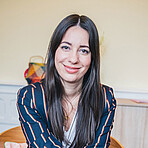“Third Places” are becoming increasingly important today as alternative work locations. What do you think makes working in public spaces so attractive?
Throughout history, “Third Places”, namely cafés, have been attractive places to work, for example for coffee house writers, journalists and philosophers.
Today, with increased flexibility in the workforce and improvements in remote technology, more people are able to choose where they work. It is therefore an attractive option to make a change and to look for a “new” temporary place of work.

Yumeng Zhu, Jeff Goldberg/Esto
As an architecture studio, you have already realised numerous “Third Places” such as libraries. In the past, libraries were mainly used for borrowing books, learning and reading. Today, they are also places for working, networking and social interaction. How do you perceive their evolution?
In addition to storing knowledge, libraries have always been places for the exchange of knowledge, dialogue and discussion – in other words, places of encounter. They must therefore be attractive to visitors and offer more than just the chance to borrow a book or read a newspaper. We always create added value with our buildings – places where people can feel comfortable, which they can conquer and “own”. It is our intention to strengthen places of encounter and exchange in cities.
Among other things, you designed the largest library in the world – the City Library in Beijing. How do you plan such an extraordinary project that has to fulfil so many different needs?
In principle, we approach all projects, whether seemingly simple or very complex, in a similar way: with an intensive examination of the location and the context. In an interdisciplinary process, a viable, strong concept is created as the basis for the design. It is about understanding the core of the task and its complexity, then we can “mould” aspects of this in-depth contextual consideration into a concept. For the City Library in Beijing, we developed a reading landscape based on the surroundings.

The City Library in Beijing is a modern centre for learning, knowledge exchange, social interaction and social engagement. How did you realise these different requirements architecturally?
It was important to us to offer users a generous space. The gently shaped indoor landscape, shaded by a “ginkgo grove”, forms a generous reading space. We used floor modelling to create different sub-areas such as retreats or conversation islands, while also integrating all other requirements, such as conference rooms or quieter reading areas. The 20 m high glass façade offers transparency and creates a connection to its surroundings.
You also planned the Far Rockaway neighbourhood library in Queens (NYC). How did you manage to get the locals to use the library as a place to work and network?
The library has been an important place for the borough of Queens since 1968 – whether as a neighbourhood centre for everyday life or as a place for disaster relief after Hurricane Sandy in 2012. The new library building with its striking façade is now intended to further strengthen its role as a community centre and place of identification. In addition to rooms that serve as meeting places, the library, which has now doubled in size, also offers other facilities that support residents in their everyday lives.

Compared to the Far Rockaway Library, the James B. Hunt Jr. Library is a very technology-focused space. Was it challenging to plan technologically advanced spaces for collaborative learning?
As I said, context and future users are extremely important to us in every project. So you could say that the challenge of planning technologically advanced learning spaces is just as great as creating appealing spaces as a meeting point in a diverse neighbourhood. In any case, a strong concept for the entire building is crucial.
How have you ensured that people enjoy coming to the James B. Hunt Jr. Library to learn, work and network despite the technology-based environment?
By also creating spacious places of well-being.
Who works here?
Kjetil Trædal Thorsen is cofounder of Snøhetta, a transdisciplinary architecture and design studio with nine studios around the world. He has been instrumental in shaping the studio’s philosophy and understanding of architecture and has played a leading role in the design of major cultural projects such as the new Bibliotheca Alexandrina in Egypt and the Norwegian National Opera. For his work, Kjetil has been honoured with the Mies van der Rohe Award – the European Union Prize for Contemporary Architecture – the Aga Khan Award for Architecture and the Global Award for Sustainable Architecture, among others.
The evolution of libraries reflects the changing needs of our society. They are no longer just places to store knowledge, but rather vibrant centres that seamlessly combine learning, working and social interaction. Projects such as the City Library in Beijing or the Far Rockaway Library in New York impressively demonstrate how well-thought-out architecture can help to promote encounters and strengthen community.
The interview with Kjetil Trædal Thorsen in the Sedus LOOKBOOK illustrates how innovative spatial concepts realise the vision of modern libraries. They are places where people find inspiration, come together and exchange ideas - proof that the ‘third place’ plays a crucial role in our flexible working and living environment.
At a time when technology and social dynamics are developing rapidly, one thing remains clear: libraries are and will remain ‘Cathedrals of the Spirit’, reminding us how important community, knowledge and creative development are for a forward-looking society.
This article is based on an interview that Bernadette Trepte conducted with the Norwegian transdisciplinary architecture and design studio Snøhetta for the Sedus LOOKBOOK.
social media channels:


